Cresa’s audio- and videoconferencing upgrade prioritizes office safety and clear communication.
As an international commercial real estate firm with more than 80 office locations worldwide, Cresa is exactly the type of company that can benefit most from the latest unified communications (UC) technology. And because of the nature of Cresa’s business—serving the real-estate needs of other high-powered companies and acting as a strategist for office planning—the company has long made it a priority to keep its conferencing systems contemporary.
“Technology is a large part of the Cresa environment, and making sure that the technology is the most up to date is of huge importance,” Cresa’s System Support Engineer, Ginger Diedrich, shared. “Cresa’s project management teams often work with clients setting up their technology within their new space. When working with clients on their environment, it is important to be knowledgeable on the technology that is out there. When a company’s technology is 10 years behind, you can’t really expect a client to honor your choices for their technology.”
Because of this need to stay in step with technological trends and maintain its reputation as a company that’s on the cutting edge, Cresa has fostered an ongoing working relationship with AV integrator Level 3 Audiovisual (L3AV). Since 2016, L3AV has completed a number of installations at Cresa’s Phoenix AZ office, mostly centered on UC solutions for conference rooms and huddle spaces, as well as the implementation of an extensive background music (BGM) system. But L3AV’s most recent project at Cresa’s Phoenix AZ location—an AV overhaul of the office’s main boardroom—went beyond the concept of “cutting edge”; in fact, the solution centered on microphone technology from Shure that had not even been released onto the market yet at the time of the installation.
The primary goals of the boardroom install were to address two pressing needs: Although the room was already equipped with an audio-conferencing system, it had to be outfitted with videoconferencing capabilities, and the system’s existing wireless microphones left a lot to be desired in terms of audio quality and aesthetics. All of the new conferencing systems also had to be integrated with Cresa’s existing RingCentral collaboration platform. And, as with all things in 2020, the ongoing novel coronavirus (COVID-19) pandemic affected the installation, influencing both the timing of the project and some of its design features.
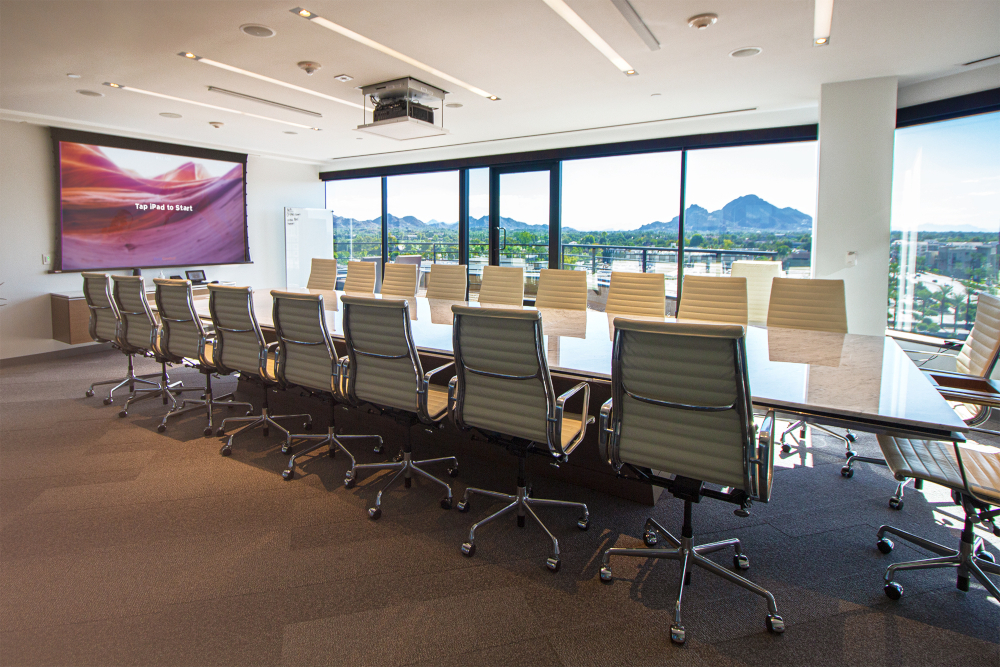
Mic Solution
Simply put, the boardroom’s old wireless mics couldn’t tame the room’s difficult acoustics. “They have glass on three sides of the room, and that caused an incredible amount of reverberance on the far end of calls,” Mique Malloy, L3AV’s Director of Business Development, described. “So, it was embarrassing for them, when they called big Fortune 500 companies about a lease for their new corporate headquarters, to have this reverberance and echo and feedback on the far end of the call.”
The old microphones also cluttered the boardroom’s expensive conference table, which detracted from the room’s aesthetics. This issue had to be addressed if the space was going to be used for videoconferencing. “The managing partner spent a lot of money on that conference room table—it’s a custom marble and walnut table—so they obviously didn’t want any drill holes for table mics or anything like that,” Malloy said. “They wanted that surface as clean as they could get it, so they definitely didn’t want any AV devices on the table. And the client hated the wireless table mics they were using, so other wireless table mics were not a solution.”
With wireless table mics out of the question, L3AV turned to ceiling mics. “[The client requested,] if there’s a solution out there that matches the sequence of the room’s linear lights, [that we] please consider that,” Malloy said. “So, we had to do two things, which [were to] balance out the acoustics of the room and then also give them an aesthetically pleasing solution that matches their lights.” He continued, “We have a lot of experience working in those fishbowl-type rooms with a lot of glass. And we have a lot of experience with the Shure MXA910s, which are two-by-two ceiling-tile ceiling mics that allow you to steer the field of mics toward the people speaking at the table. But the Shure MXA910s require much more real estate in the plenum space, so we couldn’t go with that, because there was a tremendous amount of obstructions in the plenum space.”
L3AV brought these concerns to Shure, and the manufacturer proposed a mic solution that, at the time, had yet to be officially released—namely, the Shure MXA710 linear array ceiling mic. “We started to talk to Shure, and they said, ‘We need you to sign an NDA [nondisclosure agreement], but this is a prerelease of a linear mic solution we think will work for your room.’ So, we signed the NDA,” Malloy recalled. “Shure basically said the 710s are very much like the 910s, but they will work with your environment, meaning they’ll match the custom lighting of the room, they’re extremely low profile and they hardly take up any plenum space in the ceiling. So, that just made our lives extremely easy, because those mics gave us everything we needed.”
Malloy continued, “The 710s have the same technology [as the 910s], so we were able to get a coverage pattern for the entire table by steering those mics that are built into the linear mic array. That really helped us mitigate the reverberance in the room. And if you look at the linear light system and sequence that they have on their design, the linear mics look very similar.” He added that Shure’s Senior Regional Sales Manager, Tim Valley, was instrumental in facilitating this exchange between L3AV and Shure’s sales and engineering teams.
L3AV repurposed the boardroom’s existing Biamp TesiraFORTÉ AVB AI digital audio server to work with the new MXA710 mic arrays and a Shure IntelliMix P300 audio-conferencing processor. “That combination of working with the Biamp group and working with Shure really helped us mitigate the reverberance on the far ends of calls—so much so that the managing partner just raves about it,” Malloy said. “He’s super happy. And he didn’t expect it to be so good, because I warned him quite a bit, like, ‘It’s going to be good, but it’s not going to be perfect.’ And he’s a perfectionist. So, to make him happy, it made me happy.”
Malloy credited the communication between L3AV and Shure’s engineering teams with ensuring the mic arrays worked as intended. “This was the first install in the country of the Shure mics. So, our engineers and their engineers did a lot of coordination and discussions and Teams calls to make sure that this project went off without a hitch,” he said. “We had bench-tested and done hundreds of installs of the Shure MXA910s, but this was a brand new product. So, there was that risk of having an unproven product in a room that absolutely had to work. And because of all that coordination with Shure and their engineering department, this project did work exactly how it was supposed to.”
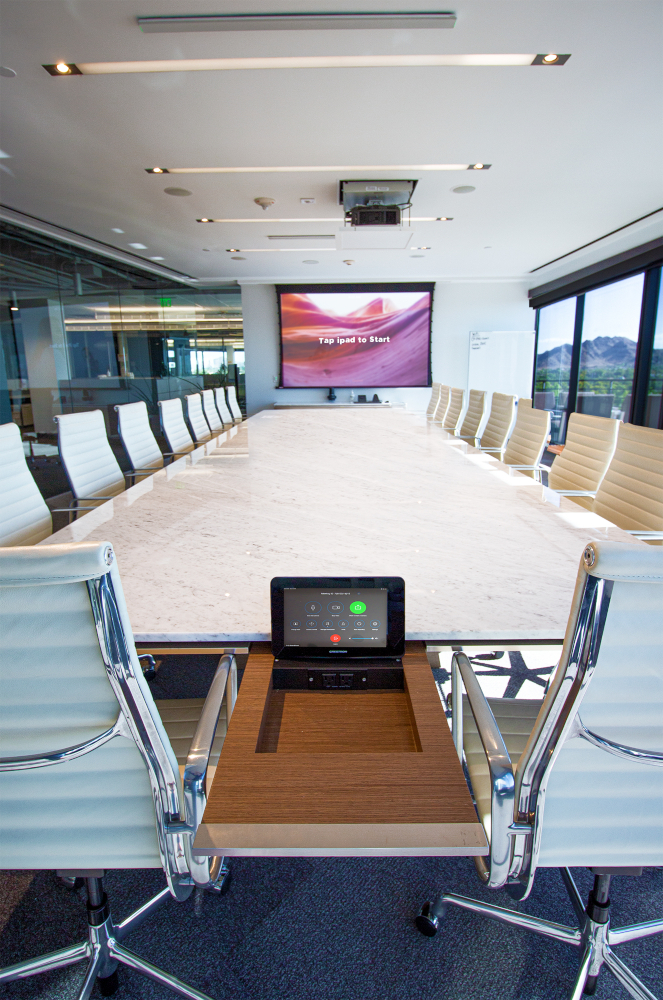
Videoconferencing & Screen Sharing
L3AV had previously outfitted the smaller conference rooms in Cresa’s Phoenix office with bring-your-own-device (BYOD)-style UC systems, and the client was looking to bring the main boardroom up to the same standard. Cresa uses RingCentral videoconferencing and collaboration software at the enterprise level, so L3AV had to ensure that the boardroom’s new UC equipment could be integrated with the RingCentral platform (as is the case with the other conference rooms). “We worked quite a bit with their [System Support Engineer], Ginger, and she was instrumental in making sure that all the conference rooms were RingCentral-friendly,” Malloy said.
Reaching this level of interoperability even included the decision to use a Logitech Rally Camera for the boardroom’s videoconferencing system. “That was actually required by RingCentral as a certified RingCentral-friendly camera,” Malloy recalled. The Rally Camera features automatic camera control with PTZ capabilities and 15x optical zoom.
A Draper Access V Electric Projection Screen installed in the only non-glass wall of the boardroom is used for video calls and screen sharing. It receives content from an NEC NP-PA501X laser projector mounted in the ceiling inside a Draper Micro Projector Lift.
“With the design of the room, we had such a small amount of drywall on that mount wall for the screen, so we couldn’t put in a large-format display,” Malloy said. “The next best thing was to put in a projection system, because the client wanted as large a screen as it could get in that small physical space on the fourth wall of the boardroom.”
Meeting participants can share content from their devices to other participants’ devices via the RingCentral system or wirelessly to the projection screen via Mersive Solstice. “In keeping with that theme of keeping it clean and keeping AV gadgets off the table, wireless sharing was something that we definitely wanted to put in for the managing partner and all the brokers, so that they could easily just push content to the projection screen,” Malloy said. “It’s kind of a [BYOD type] room, so you just bring in your laptop and you can either push content through the Mersive Solstice to the projection screen or share content through the RingCentral program.”
A Crestron DM-MD8x8 DigitalMedia switcher handles switching and routing for all the video signals, and a Crestron CP3 control system handles processing and control for the video system. Inputs on the DM switcher include the Mersive Solstice system, as well as VGA and HDMI connections located in hidden drawers in the conference table.
Another drawer hidden in the conference table contains a Crestron TST-902 wireless touchscreen, which allows for control of the conferencing system. In addition, a Crestron TSS-7 room-scheduling touchscreen is mounted near the entrance to the boardroom.
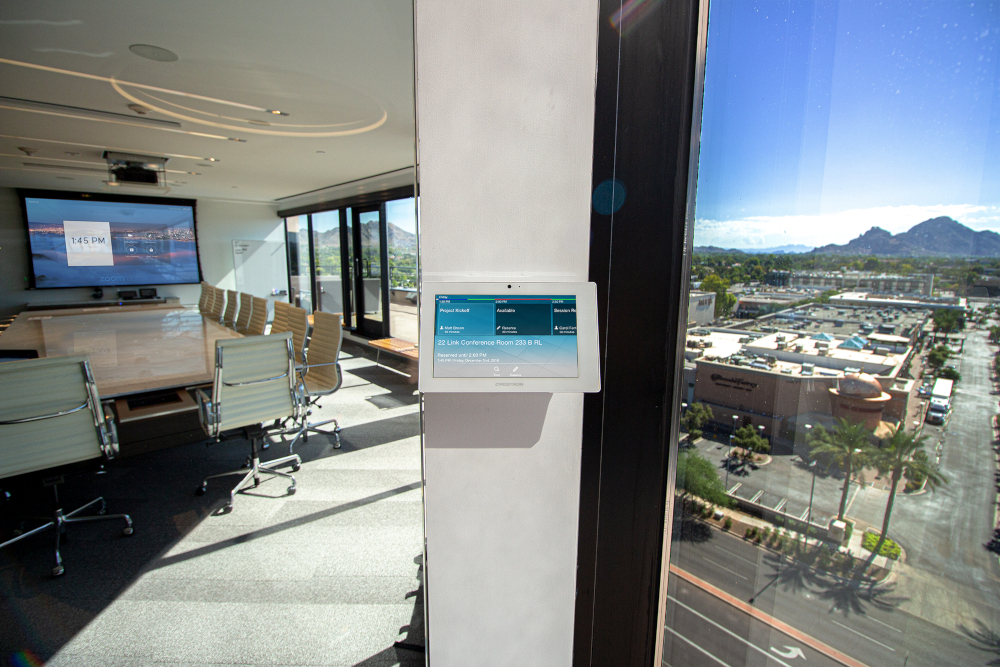
“[The control interface] was all a Biamp Tesira-based programming solution with custom programming by Level 3’s programming team,” Malloy described. “We programmed it so that you could use a dialer on the Crestron touchpanel for audio-conferencing calls.” He continued, “Every button on the user interface was a custom button: source-selection buttons, control of the projector and the projector lift, control of the projection screen, audio conferencing and even background music.”
Although most of the boardroom AV system is controlled via the Crestron touchscreen hidden in the conference table, the RingCentral software is controlled via iPad. “RingCentral is a proprietary system that they use an iPad with as their corporate standard, so we had to integrate their corporate standard into our Tesira,” Malloy explained.
According to Diedrich, the integration of these systems allows Cresa’s staff to seamlessly schedule and begin meetings using the company’s preferred platforms. “All our conference rooms are set up with a scheduler system that works with our Office 365. Any of our brokers or office personnel can book any of the rooms through Office 365,” she explained. “Office 365 is integrated with our RingCentral Rooms application as well, so when the individual opens RingCentral and creates an appointment, they [can] then reserve the boardroom or any other room. If they reserve the boardroom, they go in at their chosen time, grab the Crestron tablet for the projection equipment and turn it on; they then grab the iPad that is integrated with RingCentral and start their meeting.” She continued, “The Crestron system is integrated so well that even the camera [feed] for the room [shows up] on the iPad with RingCentral. The speaker system in the room is integrated with RingCentral as well, and can be controlled from the iPad. If we want to screen share, we log into the RingCentral meeting from our laptop as the presenter, and we can share our screen or assign someone else [as the presenter].”
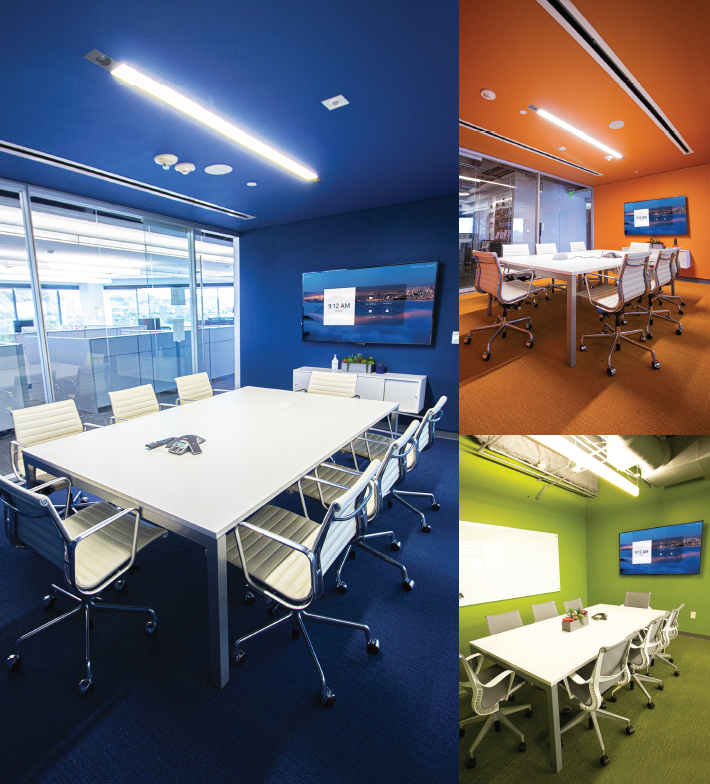
BGM System Integration
The boardroom installation also affected the office’s existing BGM system. L3AV added an expander to the Biamp TesiraFORTÉ AVB AI digital audio server so that the BGM system, which uses Biamp TEC-1s for control, could run on the same digital signal processor (DSP) as the audio-conferencing system. “That basically lets us share some of the channels on the DSP for background music so we didn’t have to have a separate DSP for it,” Malloy explained. “At the reception desk, the client can choose background music or sound masking in different zones of the office. So, they can have BGM in one area and a different channel of sound masking, or even a different streaming music source, in another.”
In the pre-COVID-19 days, the Cresa Phoenix office was frequently used to host commercial-real-estate-industry gatherings. The BGM system is robust enough to provide high-energy music for these types of functions, and it even offers wallplate connections for DJs who sometimes are hired to play music for larger events. For smaller events that take place during work hours, having independently controllable audio zones allows Cresa to use some parts of the office to entertain guests, without unnecessarily disrupting the work going on in other areas of the office.
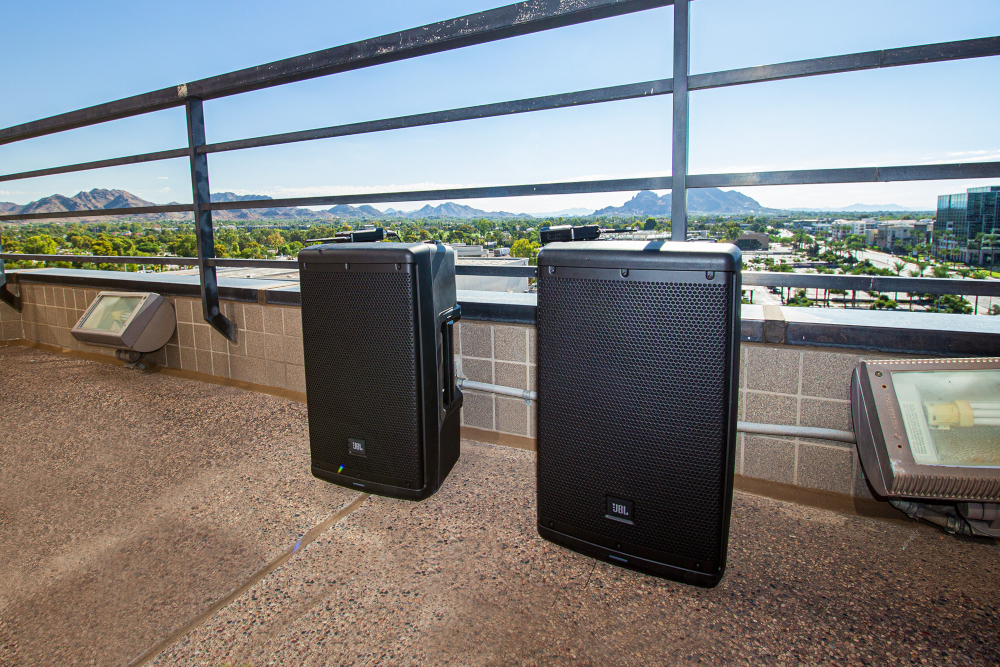
“Phoenix is a great place to hold these events, especially when it is winter on the east coast, where our corporate office is located,” Diedrich said. “If we have a high-energy event going on, we can [set] the music in the boardroom to be high energy, but still be able to keep the office system to an office selection of music. Having the ability to section off areas with different music allows us to be able to keep the business running as usual and entertain at the same time. It really is the best of both worlds.”
Impact Of COVID-19
The main boardroom project was also significantly affected by the onset of the coronavirus pandemic. Although Cresa already had plans to upgrade the main boardroom AV systems, three factors—the spread of COVID-19, the resulting shutdown orders and Cresa’s desire to ensure robust videoconferencing capabilities when employees were ready to return to the office—sped up the project timeline.
The boardroom project began in late March. “Obviously, COVID-19 hit, and there’s huge need for videoconferencing capabilities. That’s one of the needs that drove the upgrade,” Malloy recalled. “Their entire office, just like many offices, closed. No one was allowed in there, and everyone was working at home. And during that time, they realized how much they need videoconferencing capabilities, because everyone’s working from home. They were like, ‘When we get back into the office, the boardroom is going to be videoconferencing central. So, we need that capability, [and it needs to] work really well with that room’s acoustics, because we can’t have bad acoustics on a RingCentral call with our clients.”
In order to provide some peace of mind for employees when they were ready to return to the office and use the new boardroom systems, L3AV installed a 22Miles TempDefend kiosk, which is used to screen employees and guests for an elevated body temperature before they enter the office.
Diedrich explained that the main benefit of the temperature-screening kiosk is that it eliminates a potential contact point between employees and/or guests. “Including the temperature kiosk at the front door has assisted with being able to keep our staff safe. The kiosk has allowed for our front desk person to not have to do a temperature scan on individuals as they come in the door and to keep a safe distance from any possibly infected person,” she said.
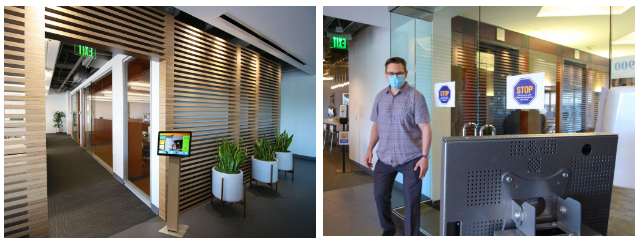
Many of Cresa’s employees have since resumed working from the Phoenix office (while, of course, adhering to public-health guidelines on social distancing). As has been the case for companies around the world, COVID-19 has entrenched videoconferencing firmly in the forefront of Cresa’s preferred means of communication. The office videoconferencing systems are now used extensively for RingCentral calls between in-office workers and at-home workers, as well as clients; moreover, the systems serve as a great proof of concept for Cresa’s clients who are looking for guidance on workplace safety in the age of coronavirus.
“The upgrade has changed the culture within Cresa, as we have moved to virtual everything during this pandemic,” Diedrich shared. “Having the ability to spread our individuals out, as per CDC [Centers for Disease Control and Prevention] guidelines, is a big deal in the conference rooms. We can showcase to our clients how we have adapted and [how we are] able to provide the same for them, if needed—and all in real time.”
Altogether, Cresa considers its investment in videoconferencing a great success and an especially welcome communications upgrade, given the timing. “The work that L3AV has completed within our office has been very advantageous,” Diedrich said. “Having the ability to have multiple places that you can have virtual meetings allows Cresa to be able to be productive while still being able to work with fellow team members, especially during a time that has limited the amount of people in the office.”
Cresa was also very satisfied with the work done by L3AV; indeed, this most recent installation has only served to strengthen the existing relationship between integrator and client. “L3AV did a great job from the start to finish. I was always kept in the loop as to where in the process we were and included in on all the conference calls addressing any issues that may have come up during the process,” Diedrich shared. “L3AV continually worked together with us as one team, with our goals and expectations always as their main objective.”
Diedrich concluded, “Testing the system was done the same day, and we ran several tests to ensure that the system was running completely prior to L3AV leaving the site. This is one of the great benefits of working with the L3AV team: They are very thorough with everything that they do, and they always make sure everything is functional before they leave the site.”
To read more from Sound & Communications, click here.